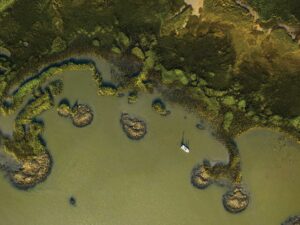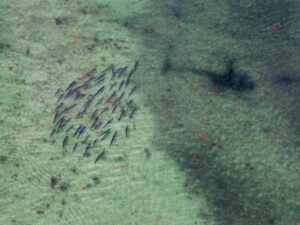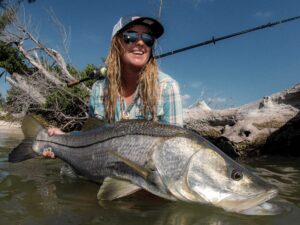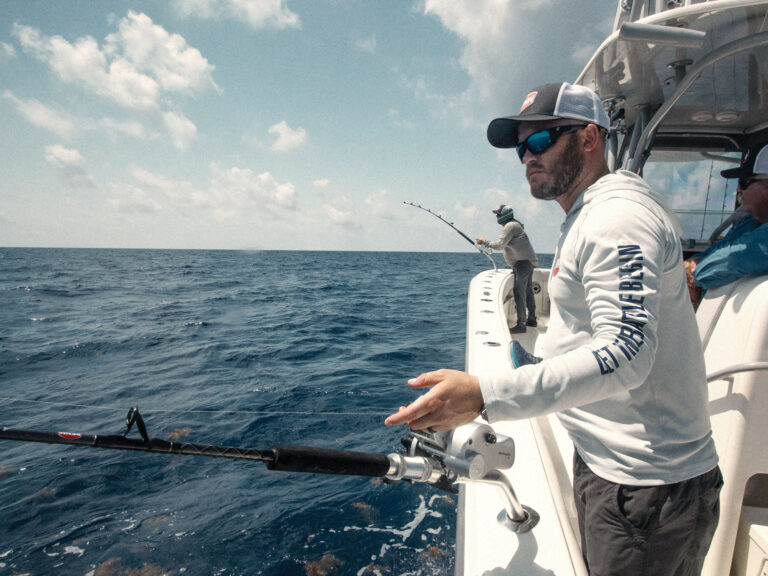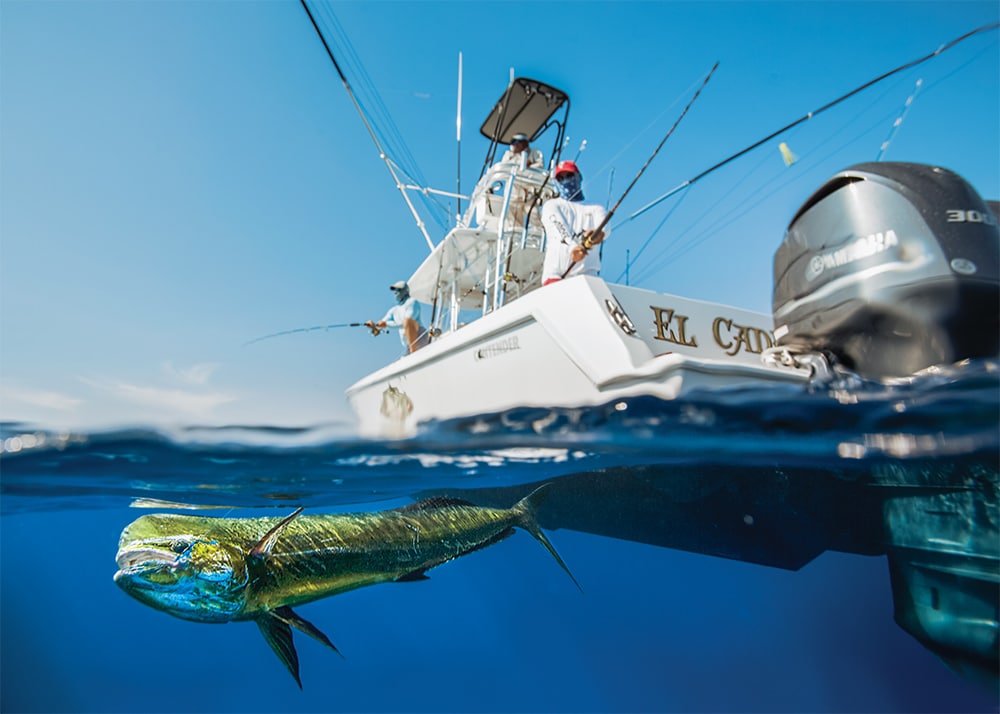
Along the mid-Atlantic coast, there’s a 50-mile stretch — between the inshore bays and offshore canyons — that often gets overlooked. A handful of sharpies who don’t brag on social media or weigh their trophies at the tackle shop, however, know dolphin and other sought-after pelagics patrol those waters, and they won’t be happy I’m divulging their secret. Although I wasn’t actually sworn to secrecy, there’s a chance I may mysteriously disappear after this article hits the newsstand.
Sneaky Gig The Graveyard of the Atlantic is renowned for its tuna and marlin offshore, and cobia and big red drum inshore, but “few anglers fish the waters in between,” says Oregon Inlet guru Capt. Aaron Kelly, who fishes off the North Carolina Outer Banks on his 30-foot center-console Rock Solid.
“Nearshore dolphin fishing has been my sneaky little gig for a long time,” he says. From late June to early September, clear, blue water pushes westward carrying dolphin and other pelagics close to shore, and Kelly says the fish show up between 3 and 16 miles offshore, the area he calls No Man’s Land. When he finds water between 78 and 82 degrees, he starts looking for dolphin.
“Many times, I spot dolphin waking on the surface,” Kelly says, but he also finds fish hiding under mats of sea grass or other floating debris. “A light southwest wind gathers the grass into long golden lines, and last summer we also had great success on abandoned pot buoys,” he recalls. Kelly often spots dolphin while patrolling for cobia and is quick to grab a medium-heavy spinning outfit rigged with a 1-ounce white bucktail. “The dolphin will shake a heavier bucktail loose,” he says, so he backs off the drag to keep the spastic dolphin from throwing the hook.
When dolphin encounters are high, Kelly rigs four cobia rods with a strip of albacore on a 7/0 hook. He can troll the strip baits along a weed line or cast to a float. And if he encounters small dolphin (called bailers) on flotsam, he breaks out the light tackle. “Catching dolphin on a trout rod is a hoot!” Kelly says, so he keeps a couple of medium-light spinning rods armed with a top-bottom rig with two ⅛-ounce jigs. “You don’t know fun until you’ve hooked two dolphin on the same rig.”
Dolphin fishing is at its best in late summer, when Kelly encounters fish ranging from 3 to 30 pounds, so he switches to a four-rod spread to cover the gamut. To match the hatch, he runs a small, naked ballyhoo on the flat line, a squid chain ahead of a strip bait, a larger ballyhoo behind a small skirt, and a larger chugger-type skirt and big ballyhoo farthest back. He runs all the lines straight off the rod tips, because he believes no drop-back is necessary. “Anyone can do that,” he says.
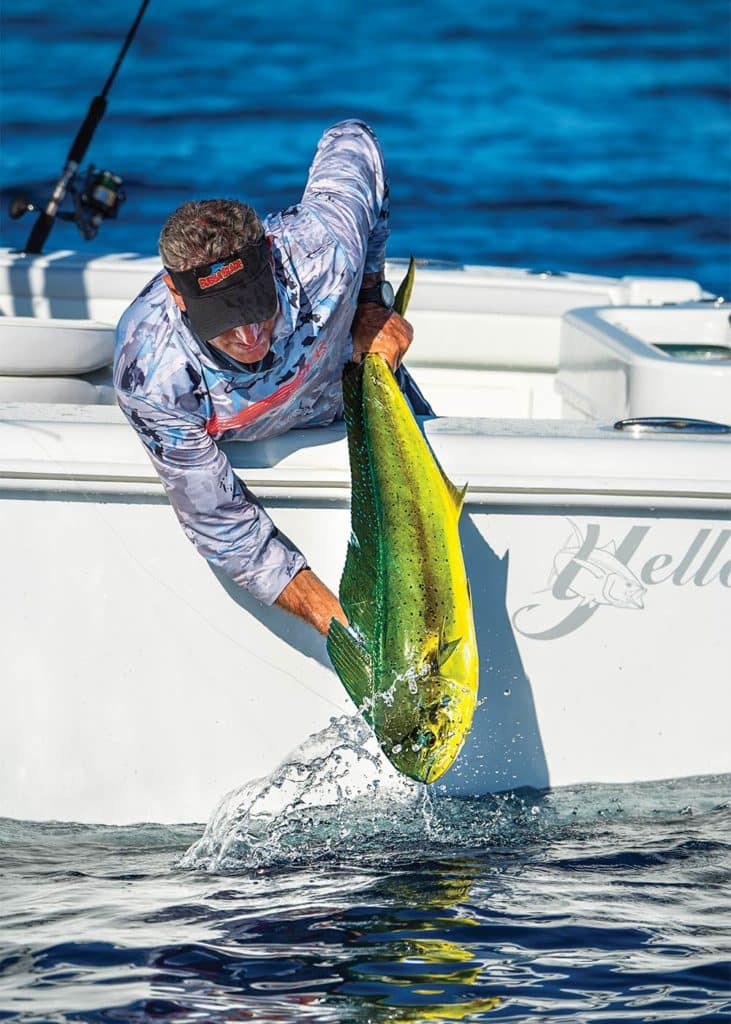
Secret Spot I first discovered nearshore dolphin while wreck-fishing off Virginia Beach, Virginia. Several times each summer, dolphin chased my bottom rig up from the wreck. If I was lucky, I would quickly pull off the sinker, drop the strip of squid back into the water, and hook the dolphin.
After a half-dozen encounters, I started rigging up a quick-switch spread like Kelly’s, to quickly turn my bottom rods into trolling outfits, and to pull strip baits and small spoons in hopes of intercepting dolphin on the move.
The more dolphin I caught, the more I wanted to target them specifically. For insight into how to rig for those nearshore fish, I hit up Capt. Jake Hiles, one of the few captains I saw trolling inside 20 fathoms. Fishing on his 35-footer Matador, Hiles covers inshore, nearshore and offshore waters out of Rudee Inlet, Virginia. “I remember catching dolphin inside Chesapeake Light Tower, 12 miles from shore, when I was a kid,” he says. The lesson must have stuck, because Hiles still knows where to find inshore dolphin.
“You can’t set your calendar by it,” he admits, but the best shot is late June and again in late August as migratory dolphin pass by the beach. Hiles looks for fish outside the plume of dirty water pouring out of Chesapeake Bay. Once he hits clear water, he checks wrecks, buoy chains, grass mats, and other flotsam for schools of dolphin. Flying fish are a good sign.
When he’s trolling, Hiles covers inshore hills and valleys that disrupt the current. “The water is shallow, so bait hides behind any irregularity in the bottom.” Hiles trolls along current rips and boils that form over these hills. “It doesn’t take more than 5 or 10 feet of variation to hold fish,” he explains.
Read Next: Summer Dolphin Pro Tactics
To target nearshore dolphin, Hiles deploys a simple spread. “I keep it to six rods,” he says. Fewer lines keep the confusion to a minimum when a pack of dolphin attacks. He starts with small ballyhoo behind a Sea Witch skirt or Iland Sailure. He adds, “Pink-and-white or blue-and-white are the best colors nearshore.”
Hiles reserves his flat lines for deep running lures. “In shallower water, dolphin often feed near the bottom,” he points out. Keeping a couple of baits below the surface will draw fish to the top. Hiles likes a Rapala Husky Magnum 25 on one flat line, and a 4½ Drone spoon behind a No. 8 planer on the other. “Since the fish are holding deep, it pays to have a lure below the surface,” he explains.
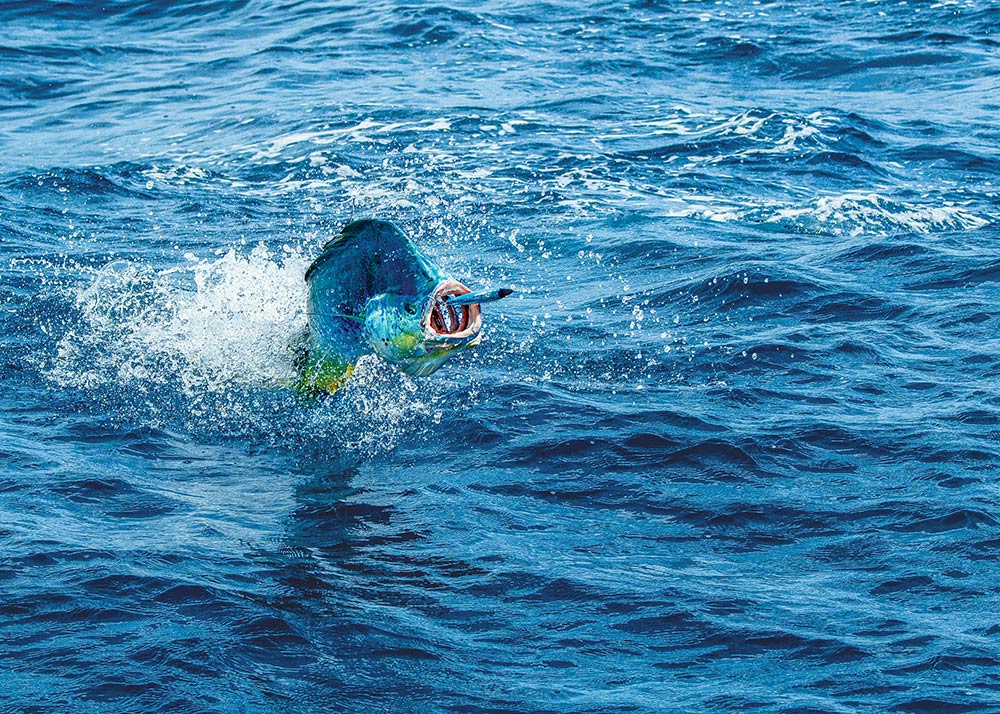
Micro Spread I got off the phone with images of my new dolphin spread running through my mind. After a few hours in the garage, I’d transformed my inshore arsenal into an offshore trolling spread.
I started by adding a 100-yard top shot of neon-blue 30-pound Momoi monofilament to the 50-pound braid using a Bimini twist to a no-name knot. At the end of the top shot, I made another Bimini loop and, with a no-name knot, attached a 25-foot length of clear 50-pound monofilament. Then I tied a 250-pound Coastlock snap swivel to the 50-pound with a uni-knot, to enable me to change rigged baits or lures in seconds.
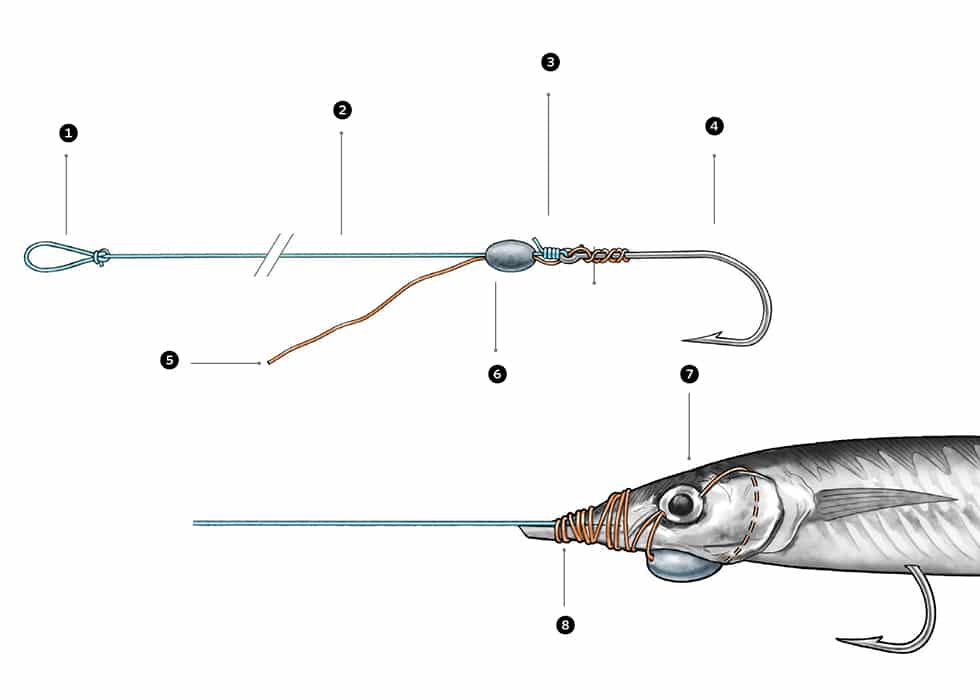
Naked Ballyhoo Trolling Rig
[2] 5 Feet of 50-Pound Leader
[3] Uni-Knot
[4] 7/0 J Hook
[5] Copper Wire
[6] 1⁄4-Ounce Egg Sinker
[7] Run Wire Behind Gill Plates
[8] Insert Wire Through Sinker, Through Eye Sockets, Then Jaws and Wrap Forward Make a perfection loop in one end of 5 feet of 50-pound fluorocarbon. Slide a 1⁄8- to 1⁄4-ounce egg sinker over the other end, and use a uni-knot to attach a 7/0 short-shank J hook. Then twist 6 inches of light copper wire to the shank of the hook, before inserting it through the hook eye and the hole in the egg sinker. Finally, double the wire back and wrap a couple more times behind the sinker to hold it in place. Thread a small ballyhoo onto the hook and use the copper wire to lash the bait to the shank. First, pass the wire one time around the bait’s gills, then two times through the eye sockets. Push the end of the wire through the ballyhoo’s snout from the bottom to seal the mouth shut, then wrap the remaining wire around the bill. I rig a dozen baits before leaving the dock and carry a couple dozen packs of small ballyhoo in the cooler for backups. Illustration by Steve Sanford
Focused Search I start the day looking for the warmest water within 30 miles of the coast on satellite water-temperature charts. Then I head to known humps and wrecks inside the warm water.
Once on the scene, I keep my 20-foot Jones Brothers center-console going at 6 knots and deploy naked ballyhoo off long riggers, short riggers and the flat line. Following Hiles’ advice, I reserved the single flat line for a large Rapala diving plug. I assign a buddy to run the boat. When we get a bite, I tell him to keep trolling and don’t stop until we’ve hooked several fish. Another buddy and I watch the rods and go into action when the chaos starts.
Read Next: How to Catch Dolphin
We don’t catch dolphin every day. Fishing nearby wrecks is a good backup plan, but when we hit the fish, we rarely catch just one. Since we started trolling close to shore, we’ve caught dolphin, wahoo and sailfish. Each time we explore the hills and wrecks within 30 miles of the beach, we discover something new.
Inshore dolphin fishing may be the best-kept secret in the mid-Atlantic. Just don’t tell anyone where you heard it.
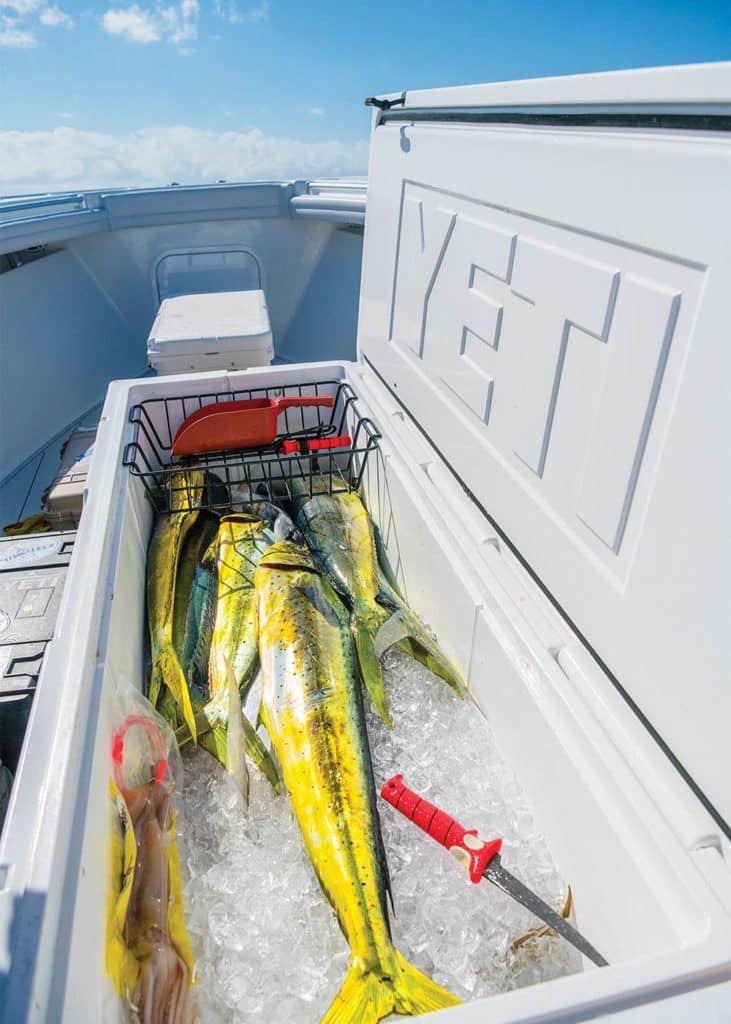
SWS Planner – Mid-Atlantic Nearshore Dolphin
What: Trolling the humps and wrecks inside 30 miles for dolphin and other pelagicsWhere: Outer Banks, North Carolina, and Virginia Beach, VirginiaWhen: Late June to late AugustWho: These two captains are experts at targeting dolphin nearshore:
Outer Banks, North Carolina – Capt. Aaron Kelly 252-441-6575 rocksolidfishing.com
Virginia Beach, Virginia – Capt. Jake Hiles 757-749-6008 matadorcharters.com
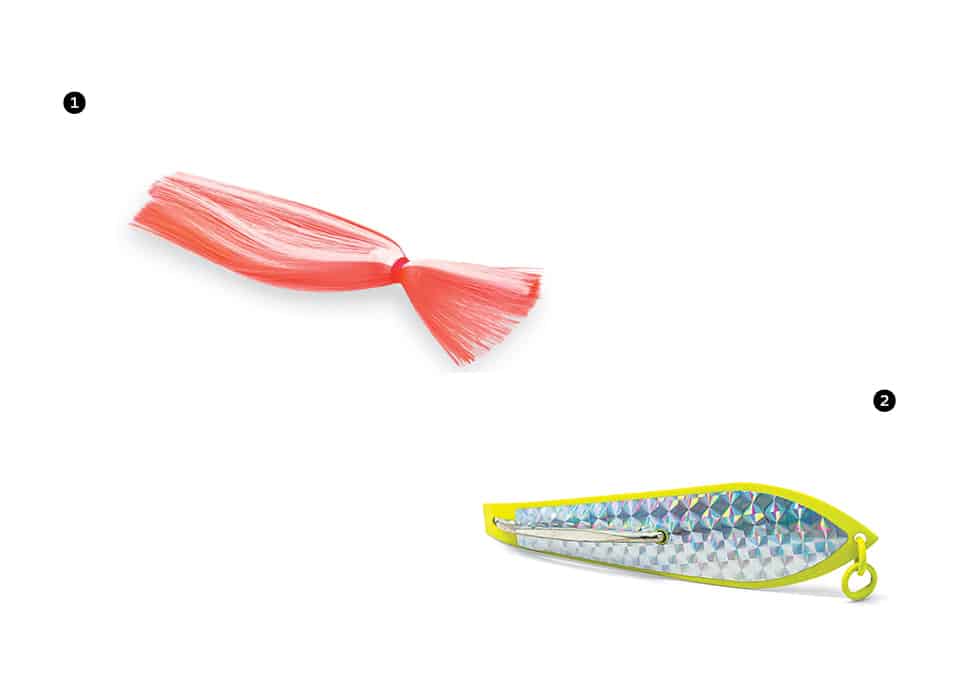
[2] 41⁄2 Drone Spoon – This proven trolling spoon is perfect for big game and works best behind a planer. Courtesy Manufacturers
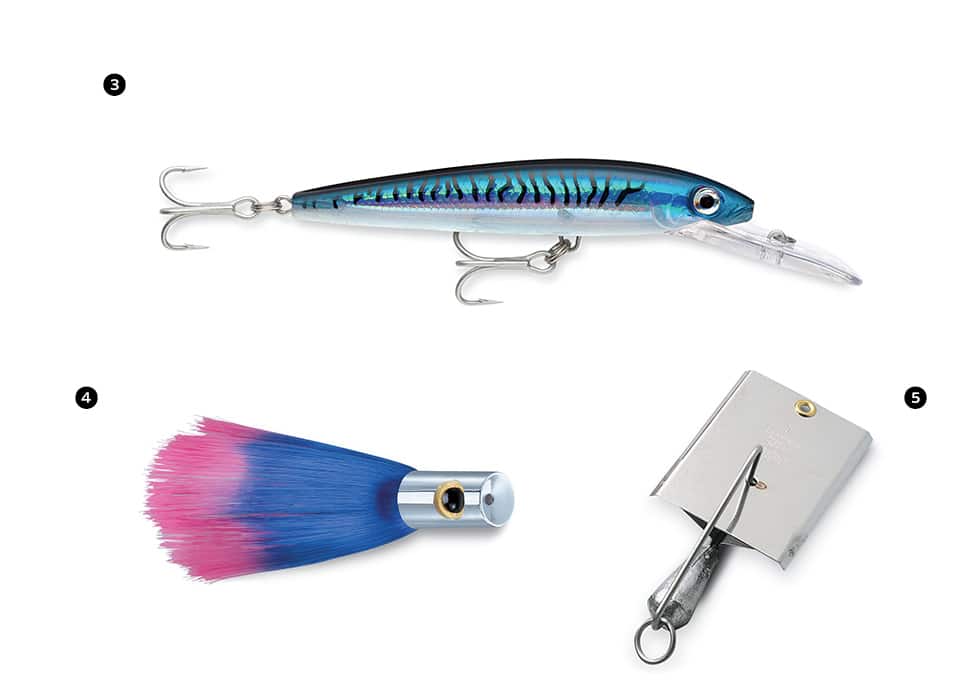
Tackle Box – Mid-Atlantic Nearshore Dolphin
Rods: 7-foot medium-heavy conventional Reel: 20-pound conventional Line: 30-pound braid, 20 feet of 50-pound mono top shot, 5 feet of 50-pound fluorocarbon leader Bait: Naked ballyhoo rigged on Mustad O’Shaughnessy J hook Lures: Rapala Husky Magnum 25, Sea Witch skirts, Iland Sailure, 41⁄2 Drone spoon


